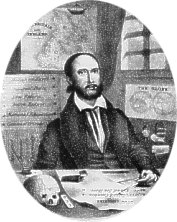

[Based on a talk given by Roger Sims, Archivist of Manx National Library].
Born Marseilles, son of a wigmaker; sent to Naples in 1810, aged 13 and with little education, where became 'acquainted' with the brother-in-law of Davies Gilbert (a future president of the Royal Society). This relationship enabled him to come to London in 1816 and in 1817 to act as secretary to Prince Castecicala, ambassador in Paris. He began to decode the diplomatic correspondence and sold it to the French Minister of Police - the assassination in 1820 of the Duc de Berry (heir to Bourbon throne) saw him sent to Naples where he inveigled himself into King Ferdinand's ministry though this arrangement was short-lived. Baume then thought it better to live for some two years in religious retreat with his 'spiritual advisor' the Duc de Rohan (future Archbishop of Rheims). Even by 25 Baume had acquired considerable wealth by various shady deals - including acting as debt collector for the Prince Regent.
In 1827 Baume was back in London where for the next decade or so he acted as a link between French and British radicals as well as selling his services to the intelligence service of both governments. He lived in an incestuous relationship with his sister Charlotte by whom he had a son and a daughter who along with her mother died in childbirth. Baume sold the bodies of both mother and child to the anatomists at University College in 1832 - a hostile crowd accused him of their murder and by 1835 was known as the 'Islington Monster'. His son was publicly 'christened' by Robert Owen. He was also consolidating his wealth by investing in property around London which possibly enabled him to move back, in the 1840s, into the literary and scientific bourgeois society (using as link a friendship with Sir George Staunton). By the mid 1850s he had moved to Manchester where he involved himself with various educational ventures, temperance and liberal politics.
He started to acquire property on the Island in 1858 - by the mid 1860s he had moved to the Island where apparently he was fascinated by the Manx way of life. However he had encountered the Island in earlier days - he had proposed to visit in 1834 but that came to nothing - he was associated with the Mona Union Rechabite Tent, in the minute containing the first suggestion that Mr. Baume should be admitted as an honorary member, he is simply described as "the Frenchman.".
In 1884 J.W Swinnerton sculptured a bronze bust of the late Mr. Baume, modelled from a cast taken after death
Late in 1897 the trustees realised the estate and gave Nine Scholarships to King William’s College, £3,000 ; School of Navigation, &c., Peel £3,000 ; School of Art, £300 ; Scholarship to Royal Academy of Music, £300 ; and the payment of the debt on the Industrial Home (£2,000).
1908: £1,000 for Ramsey Cottage Hospital
In 1918 some 58 Pictures from the brush of the late Mr John M. Nicholson, were acquired as the nucleus of a Manx National Collection. The Pictures were purchased by Mr D. Maitland, S.H.K., in his capacity as surviving devisee under the will of the late Pierre Henri Josef Baume.
K. Forrest Manx Recollections chap 25 1893
A.N. Laughton Manx Yarns chapter 4, 1905
Baume's Money Manx Quarterly #12 pp1227/9 June 1913
The Nicholson Pictures Manx Quarterly #20 pp283/6 April 1919
The Manx Museum has an extensive collection of his papers, diaries etc which have only recently been acquistioned and catalogued. These are continuing to shed much light, both on his life and also that of Radical London, in early to mid19th Century.
|
|
||
|
|
||
|
Any comments, errors or omissions
gratefully received The
Editor |
||